Reinforcement learning operates like training a puppy—through trial and error. Agents interact with environments, taking actions in various states to earn rewards. They develop policies (decision strategies) that balance exploring new possibilities with exploiting known successes. Think of a self-driving car learning when to brake at intersections or a robot figuring out how to navigate obstacles. The magic happens when these systems start maximizing long-term payoffs instead of just immediate treats. The journey from novice to master is where things get interesting.
The dance between an agent and its environment forms the enchanting foundation of reinforcement learning. Like a chess player contemplating their next move, RL agents navigate complex decision spaces by interacting with the world around them. The environment—whether it’s a digital simulation, robotics platform, or abstract dataset—responds to each action with feedback, creating a continuous loop of action and reaction that drives learning forward.
Think of states as snapshots of reality. Your self-driving car recognizes it’s at an intersection (state), decides to turn right (action), and receives positive feedback when it successfully navigates without incident (reward). This triumvirate of state-action-reward forms the core vocabulary of reinforcement learning. The agent’s goal? Rack up as many points as possible over time, like a video game character collecting coins.
Policies govern behavior—they’re fundamentally the agent’s playbook. A deterministic policy is like that friend who *always* orders the same dish at restaurants, while stochastic policies roll the dice occasionally. The ideal policy is the holy grail, promising maximum returns over time. The ultimate objective of reinforcement learning is to develop strategies that maximize cumulative rewards throughout the agent’s lifespan.
Value functions help agents evaluate situations. They’re like having a crystal ball that whispers, “This state is worth 10 points if you follow your current strategy.” Q-functions take this further by rating specific action choices in each state—practically answering “Should I turn left or right at this intersection?” The learning process often employs temporal difference learning to update value estimates based on partial experiences rather than waiting for complete episodes.
Every agent faces the classic dilemma: explore or exploit? Should you try that new restaurant, or return to your reliable favorite? Too much exploration wastes time; too little means potentially missing out on better strategies.
Returns represent the long-term payoff, often discounted because immediate rewards usually matter more than distant ones. Think of it as compound interest in reverse—a dollar today is worth more than a promised dollar next year.
Whether learning through direct experience or building mental models, reinforcement learning agents gradually improve their strategies, turning the initial awkward dance with the environment into an elegant waltz of ideal decision-making.









